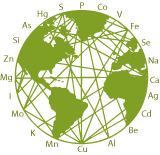Copper Exposure
Copper is a metal that occurs naturally in the environment, and also in plants and animals. Low levels of copper are essential for maintaining good health. High levels can cause harmful effects such as irritation of the nose, mouth and eyes, vomiting, diarrhea, stomach cramps and nausea.
Copper is used to make many different kinds of products like wire, plumbing pipes, and sheet metal. Copper is also combined with other metals to make brass and bronze pipes and faucets. Copper compounds are commonly used in agriculture to treat plant diseases like mildew, for water treatment and, as preservatives for wood, leather, and fabrics.
Copper is released into the environment by mining, farming, and manufacturing operations and through waste water releases into rivers and lakes. Copper is also released from natural sources, like volcanoes, windblown dusts, decaying vegetation, and forest fires.
Potential Exposure
- Breathing air, drinking water, eating foods, or having skin contact with copper, particulates attached to copper, or copper-containing compounds.
- Drinking water may have high levels of copper due to copper pipes and acidic water.
- Lakes and rivers that have been treated with copper compounds to control algae, or that receive cooling water from power plants, can have high levels of copper. Soils can also contain high levels of copper, especially if near copper smelting plants.
- Copper-containing fungicides
- Living near, or working in copper mines
Health risks due to overexposure
Breathing high levels of copper can cause irritation of nose and throat. Ingesting high levels of copper can cause nausea, vomiting, and diarrhea. Very-high doses of copper can cause damage to liver and kidneys.. Copper has not been classified as carcinogenic.
Postpartumdepression (PPD) and psychosis are directly connected to elevated levels of copper.
Menkes disease and Wilson’s disease are inherited disorders of copper metabolism resulting from the absence or dysfunction of homologous copper-transporting ATPases that reside in the trans-Golgi network of all cells. Despite striking differences in the clinical presentation of these two diseases, the respective ATPases function in precisely the same manner within the cell and the unique clinical features of each disease are entirely the result of the tissue-specific expression of each protein. The result is that copper accumulates in liver, brain and other vital organs. (Gitlin 1999)
Diagnostics:
Copper is found throughout the body; in hair, nails, blood, urine, and other tissues. High levels of copper in these samples indicate exposure to higher- than normal levels of copper.
The EPA requires that levels of copper in drinking water be less than 1.3 mg of copper per one liter of drinking water (1.3 mg/L). The WHO and the EU have set the maximum contaminant value at 2.0mg/L.
References
- Agency for Toxic Substances and Disease Registry (ATSDR). 2004. Toxicological Profile for Copper. Atlanta, GA: U.S. Department of Health and Human Services, Public Health Service.
- Gitlin JD, Schaefer M. Wilson’s disease and Menkes disease. American Journal of Physiology-Gastrointestinal and Liver Physiology Vol. 276, No. 2
- Pfeiffer CC. Mental and Elemental Nutrients: A Physician's Guide to Nutrition and Health Care. Keats 1975
